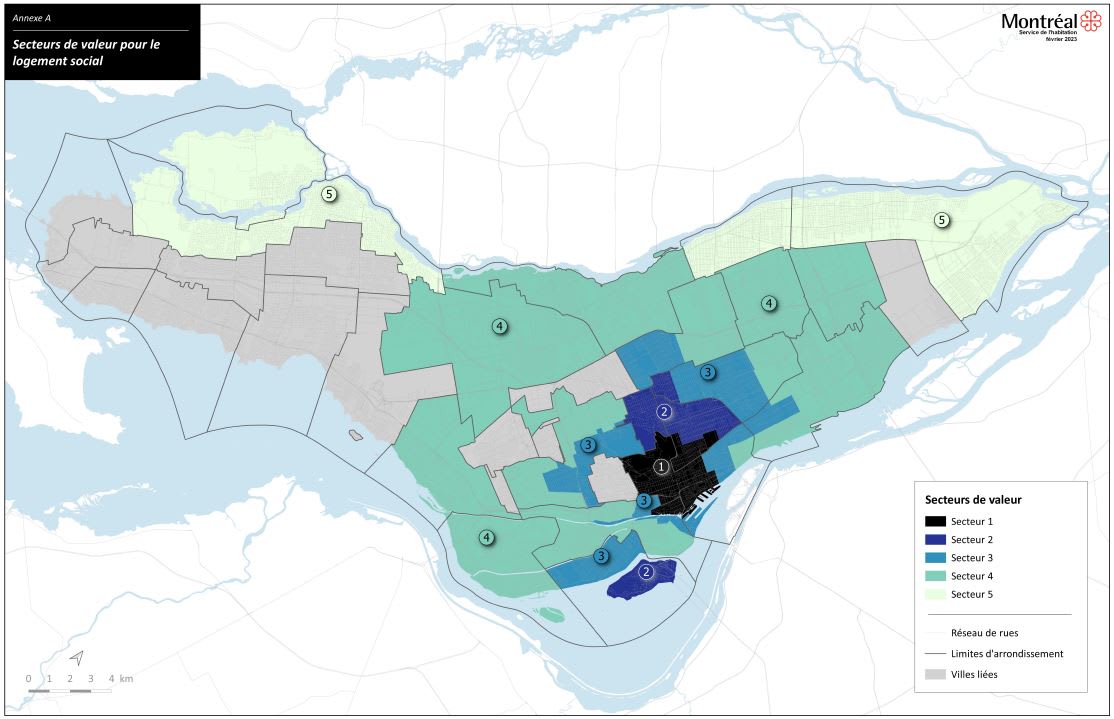Diverse metropolis: Use the calculation tool
The By-law for a Diverse Metropolis sets out various obligations around housing. Real estate developers must contribute to Montréal’s supply of social, affordable and family housing. Here’s how to use our contribution calculation tool.
A contribution is required for all projects whose residential area is greater than the threshold set in the by-law. This applies to projects involving the addition of at least 1 dwelling unit, whether it is a new construction or the conversion of an existing building.
Social, affordable and family housing contributions depend on two factors:
- Project location (value area, affordable housing zone)
- Project scope (residential area, number of housing units)
To promote housing starts, certain temporary rules are in force until December 31, 2026:
- The regulatory threshold set by the by-law is raised from 450 m² to 1800 m².
- The conversion of office use to dwelling units in area 1 of the by-law (corresponding approximately to the downtown) is exempted.
How to use the tool
There are two ways to search: by lot number and by area.
The results obtained are based on the calculation values of the current year. Please note that these are indexed on January 1 of each year.
Search by lot number
If you know the lot number(s) where the project will be built, this is the most effective search method. Enter one of the lot numbers and the tool will determine the area and zone where the lot is located.
Then, enter the total residential area and the number of dwelling units. The tool will calculate the required contribution for the three components.
Search by area
If you don’t know the lot number, you can select the value area in which the project will be located.
Areas
Areas are numbered from 1 to 5 and are used to calculate social, family and affordable housing contributions. If the project’s location is in more than one value area, the contribution is calculated according to the area for which the amount is higher.
Affordable housing zones
Some areas include affordable housing zones. In these zones, the affordable housing contribution is a percentage of the project. There are of two types of zones:
- Affordable zone 1: 10 per cent of the project
- Affordable zone 2: 20 per cent of the project
Affordable housing zones are created progressively based on amendments to the former Master plan or on residential density increases resulting from the new 2050 Land Use and Mobility Plan. Find out more.
Outside these zones, only projects with an area greater than 4,500 m2 are subject to the affordable housing contribution, with the exception of projects for which an agreement has been reached under the by-law during the period from March 20, 2024 to December 31, 2026.
Project characteristics
Once you have entered the area or lot number, you must provide the residential area and number of units for your project.
Residential area is the total floor area, including common areas (e.g., mezzanines, stairways, elevators and entranceways). It does not include commercial space, parking lots and parts of the basement that are not occupied by dwellings or parts of dwellings.
When using the calculation tool, the following dimensions must be excluded from the declared residential floor area:
- Floor area of social housing;
- Floor area of affordable housing subject to controlled resale pricing for at least 20 years
- Floor area of off-market housing managed by a non-profit organization, a cooperative, a government or paramunicipal organization, a public academic establishment, a university, or a social trust, provided that they comply with certain conditions listed in the by-law.
For more information, please consult the by-law or contact the Service de l’habitation at: [email protected].
For the period from March 20, 2024 to December 31, 2026, a conversion of office use to dwelling units in area 1 of the by-law (corresponding approximately to the downtown) will no longer be considered as an addition to the residential area.
The number of dwellings is used to calculate the family housing contribution. Only residential projects with at least 50 dwellings must contribute to private family housing.
Quick search
Need help?
Contact us if you have questions.
Are you sure you want to leave this page?
This page is not available in English. You will be redirected to the English home page.




